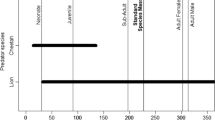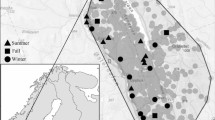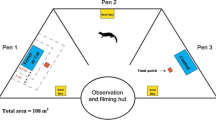Abstract
While handling large kills, mesocarnivores are particularly vulnerable to kleptoparasitism and predation from larger predators. We used 35 years of observational data on cheetah (Acinonyx jubatus) hunts in Serengeti National Park to investigate whether cheetahs’ prey handling behavior varied in response to threats from lions (Panthera leo) and spotted hyenas (Crocuta crocuta). Male cheetahs and single females, whose main threat was kleptoparasitism, minimized time on the kill by being less vigilant and eating quickly, thereby shortening their handling times. Mothers with cubs showed a different strategy that prioritized vigilance over speed of eating, which increased time spent handling prey. Vigilance allowed them to minimize the risk of their cubs being killed while giving cubs the time they need to eat at the carcass. Flexible behavioral strategies that minimize individual risk while handling prey likely allow mesocarnivores to coexist with numerous and widespread apex predators.
Significance statement
Medium-sized carnivores like cheetahs face the challenge of coexisting with larger carnivores that steal their kills and kill their cubs. We investigated how cheetahs modify their behavior on kills to minimize risks from larger predators. Using 35 years of data on 400+ cheetah hunts across 159 individuals, we found that cheetahs without cubs whose primary danger is having their kill stolen spent little time engaged in vigilance and instead ate quickly, reducing the risk of theft. Mothers with cubs, however, took a slower approach and were more vigilant while handling prey to avoid cub predation by lions and spotted hyenas. The ability of cheetahs to modify their prey handling behavior depending on the type of risk they face likely allows them to coexist with numerous larger carnivores.



Similar content being viewed by others
References
Arjo WM, Pletscher DH (1999) Behavioral responses of coyotes to wolf recolonization in northwestern Montana. Can J Zool 77:1919–1927
Balme GA, Miller JRB, Pitman RT, Hunter LTB (2017) Caching reduces kleptoparasitism in a solitary, large felid. J Anim Ecol 86:634–644
Beddington JR, Hassell MP, Lawton JH (1976) The components of arthropod predation: II. The predator rate of increase. J Anim Ecol 45:165–185
Bindoo M, Aravindan CM (1992) Influence of size and level of satiation on prey handling time in Channa striata (Bloch). J Fish Biol 40:497–502
Blumenschine RJ, Caro TM (1986) Unit flesh weights of some east African bovids. Afr J Ecol 24:273–286
Bøving PS, Post E (1997) Vigilance and foraging behaviour of female caribou in relation to predation risk. Rangifer 17:55–64
Broekhuis F, Cozzi G, Valeix M, McNutt JW, Macdonald DW (2013) Risk avoidance in sympatric large carnivores: reactive or predictive? J Anim Ecol 82:1098–1105
Broekhuis F, Thuo D, Hayward MW (2018) Feeding ecology of cheetahs in the Maasai Mara, Kenya and the potential for intra- and interspecific competition. J Zool 304:65–72
Brown JS (1988) Patch use as an indicator of habitat preference, predation risk, and competition. Behav Ecol Sociobiol 22:37–47
Carbone C, Frame L, Frame G, Malcolm J, Fanshawe J, FitzGibbon C, Schaller G, Gordon IJ, Rowcliffe JM, du Toit JT (2005) Feeding success of African wild dogs (Lycaon pictus) in the Serengeti: the effects of group size and kleptoparasitism. J Zool 266:153–161
Caro TM (1987) Cheetah mothers’ vigilance: looking out for prey or for predators ? Behav Ecol Sociobiol 20:351–361
Caro TM (1994) Cheetahs of the Serengeti Plains: group living in an asocial species. University of Chicago Press, Chicago
Caro TM (1995) Short-term costs and correlates of play in cheetahs. Anim Behav 49:333–345
Cooper AB, Pettorelli N, Durant SM (2007) Large carnivore menus: factors affecting hunting decisions by cheetahs in the Serengeti. Anim Behav 73:651–659
Croy MI, Hughes RN (1991) The influence of hunger on feeding-behavior and on the acquisition of learned foraging skills by the 15-spined stickleback, Spinachia spinachia L. Anim Behav 41:161–170
Darnell AM, Graf JA, Somers MJ, Slotow R, Szykman Gunther M (2014) Space use of African wild dogs in relation to other large carnivores. PLoS One 9:e98846
Dunphy-Daly MM, Heithaus MR, Wirsing AJ, Mardon JSF, Burkholder DA (2010) Predation risk influences the diving behavior of a marine mesopredator. Open Ecol J 3:8–15
Durant SM (1998) Competition refuges and coexistence: an example from Serengeti carnivores. J Anim Ecol 67:370–386
Durant SM (2000a) Living with the enemy: avoidance of hyenas and lions by cheetahs in the Serengeti. Behav Ecol 11:624–632
Durant SM (2000b) Predator avoidance, breeding experience and reproductive success in endangered cheetahs, Acinonyx jubatus. Anim Behav 60:121–130
Durant SM, Caro TM, Collins DA, Alawi RM, Fitzgibbon CD (1988) Migration patterns of Thomson’s gazelles and cheetahs on the Serengeti plains. Afr J Ecol 26:257–268
Estes R (1991) The behavior guide to African mammals. University of California Press, Berkeley
Favreau FR, Goldizen AW, Pays O (2010) Interactions among social monitoring, anti-predator vigilance and group size in eastern grey kangaroos. Proc R Soc Lond B 277:2089–2095
Fuller TK, Keith LB (1981) Non-overlapping ranges of coyotes and wolves in northeastern Alberta. J Mammal 62:403–405
Garvey PM, Glen AS, Pech RP (2015) Foraging ermine avoid risk: behavioural responses of a mesopredator to its interspecific competitors in a mammalian guild. Biol Invasions 17:1771–1783
Gorman ML, Mills MG, Raath JP, Speakman JR (1998) High hunting costs make African wild dogs vulnerable to kleptoparasitism by hyaenas. Nature 852:1992–1994
Harrington LA, Harrington AL, Yamaguchi N, Thom MD, Ferreras P, Windham TR, Macdonald DW (2009) The impact of native competitors on an alien invasive : temporal niche shifts to avoid interspecific aggression. Ecology 90:1207–1216
Hayward MW, Hofmeyr M, O’Brien J, Kerley GIH (2006) Prey preferences of the cheetah (Acinonyx jubatus) (Felidae: Carnivora): morphological limitations or the need to capture rapidly consumable prey before kleptoparasites arrive? J Zool 270:615–627
Hilborn A, Pettorelli N, Orme CDL, Durant SM (2012) Stalk and chase: how hunt stages affect hunting success in Serengeti cheetah. Anim Behav 84:701–706
Hunter JS, Durant SM, Caro TM (2007a) To flee or not to flee: predator avoidance by cheetahs at kills. Behav Ecol Sociobiol 61:1033–1042
Hunter JS, Durant SM, Caro TM (2007b) Patterns of scavenger arrival at cheetah kills in Serengeti National Park Tanzania. Afr J Ecol 45:275–281
Lamprecht J (1978) The relationship between food competition and foraging group size in some larger carnivores. Ethology 46:337–343
Laurenson MK (1994) High juvenile mortality in cheetahs (Acinonyx jubatus) and its consequences for maternal care. J Zool 234:387–408
Laurenson MK (1995) Behavioral costs and constraints of lactation in free-living cheetahs. Anim Behav 50:815–826
Lima SL (1995) Back to the basics of anti-predatory vigilance: the group-size effect. Anim Behav 49:11–20
Lima SL, Dill LM (1990) Behavioral decisions made under the risk of predation: a review and prospectus. Can J Zool 68:619–640
Messier F (1994) Ungulate population models with predation: a case study with the north American moose. Ecology 75:478–488
Mills MGL, Mills MEJ (2014) Cheetah cub survival revisited: a re-evaluation of the role of predation, especially by lions, and implications for conservation. J Zool 292:136–141
Mukherjee S, Zelcer M, Kotler BP (2009) Patch use in time and space for a meso-predator in a risky world. Oecologia 159:661–668
Murdoch W, Briggs C, Nisbet R (2003) Consumer-resource dynamics. Princeton University Press, Princeton
Murphy KM, Felzien GS, Hornocker MG, Ruth TK (1998) Encounter competition between bears and cougars: some ecological implications. Ursus 10:55–60
Nakagawa S, Schielzeth H (2013) A general and simple method for obtaining R2 from generalized linear mixed-effects models. Methods Ecol Evol 4:133–142
Pettorelli N, Coulson T, Durant SM, Gaillard J-M (2011) Predation, individual variability and vertebrate population dynamics. Oecologia 167:305–314
Prugh LR, Stoner CJ, Epps CW, Bean WT, Ripple WJ, Laliberte AS, Brashares JS (2009) The rise of the mesopredator. Bioscience 59:779–791
Randall JA, Boltas King DK (2001) Assessment and defence of solitary kangaroo rats under risk of predation by snakes. Anim Behav 61:579–587
Ritchie EG, Johnson CN (2009) Predator interactions, mesopredator release and biodiversity conservation. Ecol Lett 12:982–998
Roberts G (1996) Why individual vigilance declines as group size increases. Anim Behav 51:1077–1086
Sih A (1985) Predation, competition, and prey communities: a review of field experiments. Annu Rev Ecol Syst 16:269–311
Sinclair ARE, Arcese P (1995) Serengeti II: dynamics, management, and conservation of an ecosystem, vol 2. University of Chicago Press, Chicago
Smith JA, Wang Y, Wilmers CC (2015) Top carnivores increase their kill rates on prey as a response to human-induced fear. Proc R Soc B 282:20142711
Suraci JP, Clinchy M, Dill LM, Roberts D, Zanette LY (2016) Fear of large carnivores causes a trophic cascade. Nat Commun 7:10698
Swanson A, Arnold T, Kosmala M, Forester J, Packer C (2016) In the absence of a “landscape of fear”: how lions, hyenas, and cheetahs coexist. Ecol Evol 6:8534–8545
Switalski TA (2003) Coyote foraging ecology and vigilance in response to gray wolf reintroduction in Yellowstone National Park. Can J Zool 81:985–993
Toïgo C (1999) Vigilance behavior in lactating female alpine ibex. Can J Zool 77:1060–1063
Vanak AT, Fortin D, Thaker M, Ogden M, Owen C, Greatwood L, Slotow R (2013) Moving to stay in place: behavioral mechanisms for coexistence of African large carnivores. Ecology 94:2619–2631
Verdolin JL (2006) Meta-analysis of foraging and predation risk trade-offs in terrestrial systems. Behav Ecol Sociobiol 60:457–464
Acknowledgments
We are grateful to Tanzania National Parks and Tanzania Wildlife Research Institute for permission to collect data. The Howard G. Buffett Foundation, Wildlife Conservation Society, Frankfurt Zoological Society (FZS), and National Geographic Society provided funds. AH’s dissertation was funded by a National Science Foundation Graduate Research Fellowship under Grant No. DGE-1048542, a National Science Foundation Doctoral Dissertation Improvement Grant Award Number 1405491, P.E.O, and Virginia Tech. We are very grateful to Dennis Minja, Helen O’Neill, Laura Simpson, Sultana Bashir, John Shemakunde, and all other research assistants on the Serengeti Cheetah Project who helped collect data. Logistical support was provided by G. and M. Russell, B. Allen, O. Newman, A. Barrett, J. Jackson, J. Dreissen, A. Geertsma, P. and L. White, C. MacConnell and the staff at Ndutu Safari Lodge, M. Borner and others at FZS, as well as T. Mariki. AH thanks Ulrike Hilborn for data entry and general support and Ray Hilborn for help with R. We also thank Dr. Matt Hayward and an anonymous reviewer for their helpful comments.
Funding
AH’s dissertation was funded by a National Science Foundation Graduate Research Fellowship under Grant No. DGE-1048542, a National Science Foundation Doctoral Dissertation Improvement Grant Award Number 1405491, P.E.O, and GTAships from Virginia Tech.
Author information
Authors and Affiliations
Corresponding author
Ethics declarations
Conflict of interest
The authors declare that they do not have conflict of interest.
Ethical approval
All applicable international, national, and/or institutional guidelines for the care and use of animals were followed.
Additional information
Communicated by P. A. Bednekoff
Electronic supplementary material
ESM 1
(PDF 191 kb)
Rights and permissions
About this article
Cite this article
Hilborn, A., Pettorelli, N., Caro, T. et al. Cheetahs modify their prey handling behavior depending on risks from top predators. Behav Ecol Sociobiol 72, 74 (2018). https://doi.org/10.1007/s00265-018-2481-y
Received:
Revised:
Accepted:
Published:
DOI: https://doi.org/10.1007/s00265-018-2481-y




